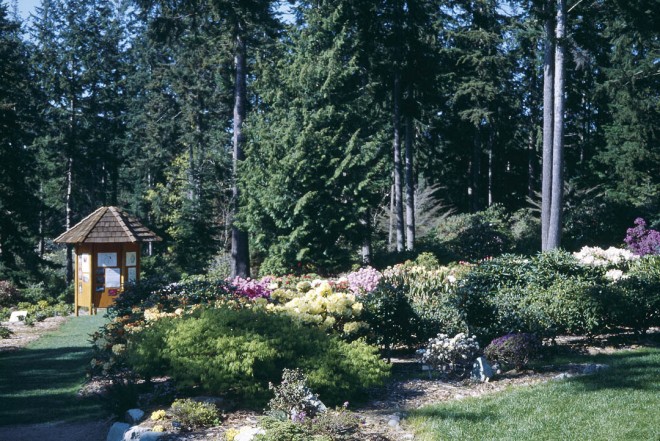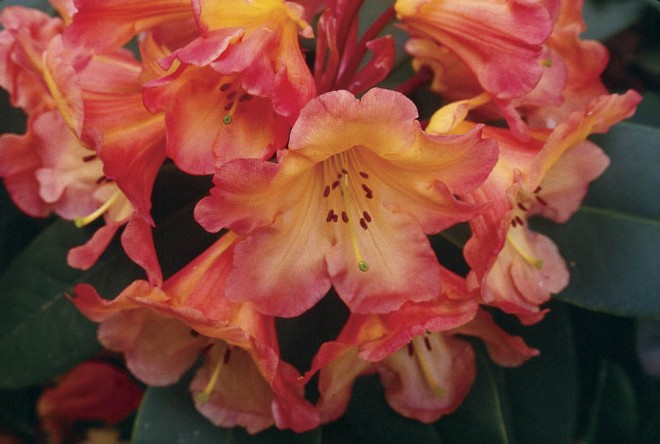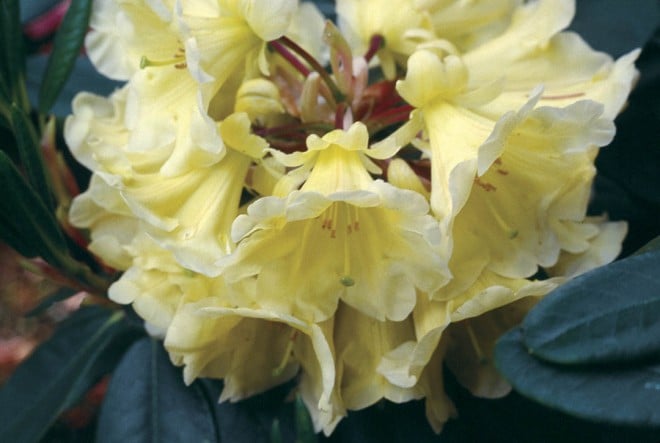
Meerkerk Rhododendron Gardens: Test Garden for Contemporary Rhododendron Hybrids

Contributor

It is the tenth of April, a sunny day abuzz with bees and people pollinating rhododendrons. Meerkerk Rhododendron Gardens’ Hybrid Test Garden is a rainbow of blossoms whose pot of gold is gilded anthers. Once only a dream, the circular labyrinth is now alive with color!
Ann and Max Meerkerk, the garden’s founders, arrived on Whidbey Island over forty years ago, deeply involved with breeding-of a different sort. Max was president of the International Weimaraner Association, which was responsible for bringing the true bloodline of these dogs from Germany to the United States. Upon visiting a friend on Whidbey, they became enchanted with the island and purchased the initial thirteen acres of forested land. With eighty-eight canines in tow, they moved to Whidbey Island to engage in the final stage of their life journey.
Inspired by the stands of native Pacific rhododendron (Rhododendron macrophyllum), and Max’s fondness for the rhododendron gardens at the Rothschild’s Exbury Estate in England, they began work on their Pacific Northwest woodland-style garden.
Soon, the infectious lure of rhododendrons overtook the Meerkerks. They collected plant specimens from England and Asia and became steady customers of the RumDum Club of Northwest Hybridizers. Nurserymen by trade, Halfdan Lem, Endre Ostbow, Lester Brandt, Bill Whitney, and Hjalmar Larson were the “treasure seekers” in the rhododendron world-hence, the Rum Dum Club. This group of American Rhododendron Society (ARS) members pursued the hidden gems of color, double flowers, bi-colors, and picotees.

From Dogs to Rhododendrons
The Meerkerks soon became hybridizers on their own. The breakthrough introduction, ‘Lem’s Cameo’, led to the Meerkerk hybrid, ‘Mary’s Favorite’, a petite, tree-form rhododendron with abundant peachy-apricot flowers and fragrance. Max’s love of the velvety underside of the leaves—the indumentum—inspired the creation of the Rhododendron bureavii cross, ‘Meerkerk Magic’. The intrigue of tree-form rhododendrons with deeply pigmented blooms, as in R. niveum, resulted in the arboreal hybrid, ‘Whidbey Island’.
Before Ann passed away in 1979, she willed that their gardens become a site for continuing the work she and Max had begun. Bequeathing the property to the Seattle Rhododendron Society, she stated:
I have envisioned for the future, a careful and methodical development of a peaceful woodland garden emphasizing rhododendrons and companion plants. In addition to being of great ornamental value, I would anticipate that the garden would be used to test, select and propagate superior plant materials.
Organization of the Meerkerk Rhododendron Gardens began. Through the dedicated work of volunteers and hybridizers from the far reaches of the globe, a new test garden was conceived. Ten nations are represented in the Test Garden, with hybrids provided by Hans Hachmann of Germany, Marjatta Uosukainen of Finland, and Hideo Suzuki of Japan. Warren Berg, Frank Fujioka, Joe Davis, Harold Greer, Jim Barlup, Elsie Watson, Edna and Lloyd Newcomb, Bill Stipe, Ted Van Veen, David Leach, Clint Smith, Yasmin Workman, and Ned Brockenbrough were among the dozens of participating hybridizers from the United States.

A Sampling of Hybridizers
The early work of the RumDum Club influenced the “middle era” of hybridizers, which included the Meerkerks. Elsie Watson, founder of the ARS’s Northwest Hybridizers Group over thirty years ago, actively participates in hybridizing and in Meerkerk’s monthly work parties. (Elsie celebrated her ninetieth birthday in 2003.) Hybridizers in the group meet at Elsie’s Kirkland, Washington, home throughout spring to share insights, pollen, and stories of trial, error, and success. The plants she has fostered into being stir the imagination. Her extensive work, searching for the most azure of the violet rhododendrons, resulted in ‘Blue Boy’. Elsie’s breeding goals also encompass early season plants, such as the winter-blooming ‘Tabitha’, and those with picotee flowers, like ‘Marley Hedges’. From big-leaf parentage, she has given the garden world ‘Pink Prelude’ and ‘Chief Sealth’, both with dramatic foliage.

Watson’s work has influenced many of the contemporary hybridizers. World-renowned plantsman Frank Fujioka named his compact picotee-flowered rhododendron ‘Elsie Watson’ in her honor. For many years, Frank visited the Lem Nursery and witnessed the Meerkerks’ transporting of dozens of fine specimens from mainland to island. Perhaps seeing Halfdan’s introductions inspired Fujioka to pursue the world of plant parenthood. Now, after thirty-six years, his creations are available to the public. Frank registers a plant only after decades of trials at his rhododendron farm on Whidbey Island, with other growers, and at the Meerkerk Test Garden. He strives to create a plant that has excellent growth habit, healthy and attractive foliage, clear floral colors, and a long flowering season. His floral alchemy combines these traits to produce plants that flower at a young age. Frank’s current series of rhododendrons exhibit lily-like florets with a fine-art appeal, incorporating the “negative space” around the flowers to showcase each blossom’s unique qualities. ‘Starbright Champagne’ (one of the first of this group of crosses between R. yakushimanum ‘Seaview Sunrise’ and ‘Lem’s Cameo’), covers itself with a multitude of shimmering ivory apricot trusses each April. New foliage emerges in a rich bronze tone and transforms into a shiny emerald canopy on a well-mannered shrub. ‘Glowing Gold’, a plant so floriferous that the foliage is occluded, is not only brilliantly colored but sun tolerant as well. Frank has been influenced by the “gold rush” in rhododendron breeding and surpassed by few in the pursuit of yellow flowers.

Rhododendron hybridizers have been searching for the elusive pot of floral gold since Rothschild’s introductions of ‘Crest’ and ‘For-tune’ in the early 1900s; their goal has been a hardy, clear yellow rhododendron. Contemporary results can be viewed in the Meerkerk Hybrid Test Garden this year. Glimpsing the array of yellows from the work of dozens of growers, it is evident that they are still panning for the ultimate nugget. Among the best yellow hybrids for the Pacific Northwest are: ‘Nancy Evans’ and ‘Horizon Monarch’ from Brockenbrough; ‘Mindy’s Love’ and ‘Invitation’ from Barlup; ‘Glowing Gold’ from Fujioka; and ‘Lemon Dream’ from Bruce Briggs and Steve McCulloch. Leach’s ‘Capistrano’, introduced through Briggs Nursery, is hardy to USDA zone 5. This is great news for gardeners east of the Cascade Mountains.

Other breeders are attempting to broaden the color range and hardiness for East Coast landscapes. Introduced to the world of color through photography and to rhododendrons through Wells Medina Nursery (in Medina, Washington), Jim Barlup has been working toward a clear orange rhododendron that is hardy and sports great foliage and form. Jim works with growers around the world, discussing hardiness and color characteristics and sharing pollen. Last year, on visiting his trial garden, I was surprised to see only one flower in bloom: an orange rose. (Yes, a rose! Perhaps he is utilizing creative visualization or a new process of gaining orange through osmosis.) Looking at his successes, one can see the progression from yellow to orange: ‘Mindy’s Love’, ‘Invitation’, ‘Honey Butter’, ‘Recital’. By combining his hybrids with others, such as ‘Lem’s Tangerine’, ‘Hill’s Low Red’, and ‘Apricot Fantasy’, the goal of an orange hybrid is in sight. Jim’s named and unnamed hybrids are major elements of the Meerkerk Hybrid Test Program.

The Next Generation
These hybridizers have not only been creating new plants, but they are also inspiring a new generation of growers. In 1993, Meerkerk Gardens hired me as garden manager-a tremendous honor. When garden intern, Oriana Simmons-Otness began working at Meerkerk in 1998, opportunities blossomed. The effervescence of youth and the enthusiasm for plants intrigued our contemporary hybridizers. The combination of wisdom, scientific technique, and whimsy—evident among Fujioka, Barlup, Watson, Gene Pflug, the Newcombs, Simmons-Otness, and me—characterizes the “modern era” of Meerkerk hybridizers.
Seedlings from crosses made in 2003 have germinated and are being grown on in hopes of realizing new combinations of qualities passed down from the parent plants. Combining pollen from yellow-indumented Rhododendron wassonii onto Barlup’s ‘Invitation’ and Fujioka’s ‘Glowing Gold’ may introduce a compact, yellow-flowered rhododendron with bronze indumentum. Watson’s ‘Fragrant Red’ combined with ‘Black Prince’ may produce a dark maroon, perfumed flower. Key objectives in the Meerkerk hybrid program include yellow, deep purple, or burgundy flowers, colorful indumentum, striking foliage, disease resistance, good form, and fragrance.
A generous grant from the American Rhododendron Society has enabled the staff at Meerkerk to upgrade the test garden through standardized soil testing, improved labeling and signage, a computerized data base, and more field research.
In 2003, the Great Plant Picks team from the Elisabeth C Miller Botanical Garden in Seattle invited me to chair the rhododendron committee. Over the next several years, this committee will identify exceptional rhododendrons in the categories of woodland, arboreal and rock garden types. Winners in each category will be tried and true, with a focus on new hybrids and species as they are tested and become available.
With these factors in alignment—mentors and students, plants and pollen, equipment and imagination—we are ushering in the “next generation” of rhododendron introductions.
Celebrating Twenty-Five Years
Meerkerk Rhododendron Gardens commemorates its twenty-fifth anniversary of public gardenhood in 2004. Today, Meerkerk Rhododendron Gardens is an independent, not-for-profit, private garden open to the public. Peak blooming season is mid-April through May, celebrated with educational programs, dance, music, and flowers.
In addition to the Hybrid Test Garden, Meerkerk showcases numerous species of Rhododendron in the Asian Garden. The Big Leaf Valley features exotic tree-form rhododendrons planted in a verdant woodland. The Ramsey Rock Garden highlights dwarf rhododendrons and companion plants. More than 100,000 spring-flowering bulbs have been planted over the last decade, making the prelude to peak rhododendron season vibrant and welcome after winter’s gray skies. A forty-three acre forest preserve with nature trails surrounds the gardens, protecting this serene habitat.
We hope you will join us in celebrating Meerkerk’s Silver Anniversary.
[sidebar]
If You Should Like to Visit…
Meerkerk Rhododendron Gardens are located on Whidbey Island, south of Greenbank, Washington-about a ninety-minute drive north of Seattle, (including a twenty-minute ferry crossing). From Seattle, take I-5 north to the Whidbey Island/Mukilteo Ferry to Clinton. From Clinton, take Hwy 525 north for fifteen miles, turn right on Resort Road, and left onto Meerkerk Lane. From the North, take Hwy 20 south to Hwy 525, and about 1.5 miles south of Greenbank, turn left onto Resort Road, and left onto Meerkerk Lane.
Meerkerk Gardens are open daily from 9 am to 4 pm. The Nursery is open on weekends during spring offering a fine assortment of rhododendrons and companion plants. General admission is $5 per adult; children under 16 are admitted free when accompanied by an adult. Special events admission varies. Guided tours for groups of ten or more may be scheduled by calling at least two weeks in advance.
For more information about visiting the gardens or about membership in the Friends of Meerkerk, write to PO Box 154, Greenbank, WA 98253, call 360/678-1912, email meerkerk@whidbey.net, or visit their website at www.meerkerkgardens.org.
[/sidebar]
Share:
Social Media
Garden Futurist Podcast
Most Popular
Videos
Topics
Related Posts

Low Maintenance Gardens – Better for Pollinators and People
Autumn 2022 “I come out every day. It’s therapy, my meditation.” Janet’s young garden transformed from overgrown, invasive plants to mostly natives. The dailiness of

Calochortophilia: A Californian’s Love Affair with a Genus
Summer 2022 I can chart the progression of my life by Calochortus. For the last two decades, at least. As a teenage girl growing up

Pacific Plant People: Carol Bornstein
Spring 2022 Public gardens play a key role in demonstrating naturalistic planting design, selecting native and adapted plants for habitat, and testing techniques for reducing

Add Year-Round Interest and Winter Blooms for Pollinators
Spring 2022 This article was created from an Interview by Merrill Jensen with Neil Bell in the Summer of 2021 for our Pacific Plant People










Responses